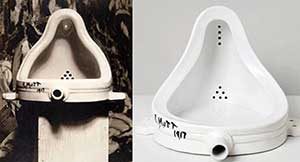 Recently, a friend challenged me to rethink my ArtPrize Ten entry by introducing me to Marcel Duchamp’s work called, Fountain (1917): a porcelain urinal turned upside down and signed with a fake name: “R. Mutt.”
Recently, a friend challenged me to rethink my ArtPrize Ten entry by introducing me to Marcel Duchamp’s work called, Fountain (1917): a porcelain urinal turned upside down and signed with a fake name: “R. Mutt.”
While Duchamp’s contemporaries showcased their highly skilled work, which no one can remember anymore, Duchamp transformed a urinal into art. Duchamp’s defiance, or sarcasm, challenged the art world.
New York’s Society of Independent Artists refused to show his piece and stated: “The Fountain may be a very useful object in its place…and it is, by no definition, a work of art.” The public called the urinal “inappropriate, vulgar, distasteful, or even, plagiarism.” Yesterday’s avant-garde rejected this artist—and his maneuver onto thin ice—when he disobeyed the rules and offended…everyone.
But Duchamp’s rebellion leaves us with some important questions. Does art have to be beautiful to be influential? Does ugly or shocking art still play an important role? Fifty years after Duchamp transformed a urinal into art, Andy Warhol’s soup cans stacked up in museums. Then after another fifty years, cultural elites voted Duchamp’s urinal as the most important modern work.
My friend’s challenge and Duchamp’s example stirred my imagination for ArtPrize Ten. As a result, my next ArtPrize work may not be just sweet paintings. And like Duchamp, some may misinterpret my work. Because this year’s work may very well venture onto Duchamp’s ice. But it’s worth the risk because our healing message—to counteract bullying and school gun violence—is so important and timely.
Photo credit: The original Fountain – Marcel Duchamp 1917 – photographed by Alfred Stieglitz
Broken Wings
Grand Rapids Public Museum
272 Pearl Street NW (west of the river)
September 19 to October 7, 2018
Vote #66688
In light of the recent tragic school shootings across America, find out how you can create positive change from national bullying specialist Jeff Veley.
Share your story #BrokenWings






